$250 Billion Yearly Economic Costs from Plastics
Air Date: Week of February 16, 2024
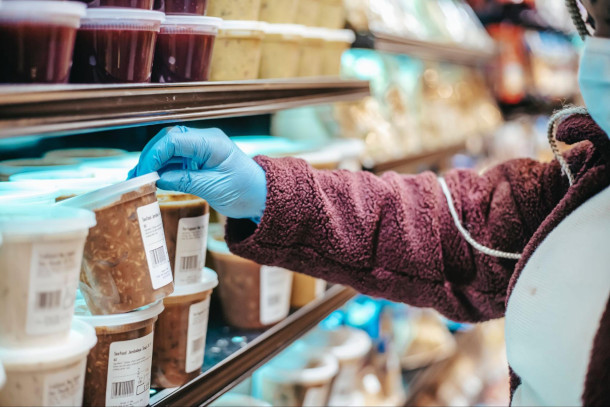
Many chemicals used in plastics disrupt normal hormone function and can hurt human health, costing the US upwards of $250 billion a year in healthcare costs. (Photo: Laura James, Pexels)
Hormone-disrupting chemicals in plastics take a yearly economic and health toll in the hundreds of billions of dollars in the U.S. alone, according to a recent study. Pediatrician Leonardo Trasande discusses the research with Host Steve Curwood and explains why PFAS, phthalates, BPA and flame retardants in plastics are so harmful to human health.
Transcript
BELTRAN: From PRX and the Jennifer and Ted Stanley Studios at the University of Massachusetts Boston, this is Living on Earth. I’m Paloma Beltran.
CURWOOD: And I’m Steve Curwood.
$250 billion. That’s the annual health and economic costs of toxins in plastics in the United States, from the plastics found everywhere, in food packaging, clothing, furniture, cookware, and even nail polish. They’ve come to permeate our environment so thoroughly that some have started calling our time the “Plasticene.” Plastic trash is ugly enough, but the invisible host of chemicals they contain wreak havoc on the hormone systems of the human body, leading to devastating and costly health outcomes. A recent study published in the Journal of the Endocrine Society found that in 2018 alone, disease and disability caused by chemicals in plastic cost the U.S. a whopping quarter of a trillion dollars in health and economic losses. Lead author Leonardo Trasande is a pediatrician who directs the NYU Center for the Investigation of Environmental Hazards and he joins me now. Dr. Trasande, welcome back to Living on Earth!
TRASANDE: Thanks for having me again, Steve.
CURWOOD: So your study focused on the costs of just a few of the thousands of chemicals that are used in plastics. What were the chemicals that you included in your study? And how do they threaten our health?
TRASANDE: So we started by focusing on brominated flame retardants. Brominated flame retardants are best known to hack thyroid hormone. The baby relies on thyroid hormone through the second trimester of pregnancy, such that even low levels of thyroid hormone can disrupt brain development in the young child and have consequences that are permanent and lifelong. Then we also focused on phthalates, chemicals used to soften plastics that not only have effects on metabolism in adults as well as kids, but disrupt sex hormone function and thereby can have effects on fertility. And these chemicals, particularly the phthalates, may have behavioral consequences not just for attention deficit, but for depression and other mental illnesses. We also looked at bisphenols used in polycarbonate plastic and aluminum can linings. Bisphenols are synthetic estrogens, they mess with fat distribution in the body by disrupting how cells in the body develop. Instead of bone or muscle, they become fat. And they disrupt the protective function of proteins that are important for heart function. And then finally, there are these forever chemicals as they're called, per and polyfluoroalkyl substances, nonstick chemicals that are used in oil- and water-resistant clothing, too. They do a host of things. They contribute to cancers, they disrupt metabolism, they can impair cognitive function. And the reason why these chemicals have such broad effects is they weren't designed with the human body in mind the way drugs are. And so you mess with hormones, you have reverberations that cut across all sorts of organ function in the body.

Plastics can be found in unexpected places like furniture, clothing, and even nail polish. (Photo: Maksim Goncherenok, Pexels)
CURWOOD: And we have an obesity epidemic in this society. How might exposure to these chemicals and plastics be related to that?
TRASANDE: So we used to think, simply calories in, calories out. And nothing I'm saying today mitigates the importance of diet and physical activity in the twin pandemics of obesity and diabetes in the U.S. and globally. But we know that chemicals can scramble our body's response to normal dietary cues. Take for example a study that followed a population of adults who had lost weight through healthy diet and physical activity. They drew a blood sample, they measured PFAS in that blood sample, and then they saw who gained weight back the fastest. The ones who gained the most weight back were the ones with the highest levels of PFAS. And then they dug in deeper. And they found that the resting metabolic rate of those adults had actually slowed down in relationship to the chemicals. So talk about the body's thermostat being turned the wrong way.
CURWOOD: Now your study found that using these chemicals in plastics costs us some $250 billion in U.S. health costs a year, I guess you said maybe between 225 and 275. But it's still a huge number. So what kind of costs did you include in those calculations?
TRASANDE: Well, to just start at the basic level, we looked at direct medical care costs, doctor's visits, prescriptions, emergency room visits, hospitalizations. But you have to dig deeper, because there are downstream costs that are terribly important at a societal level. And we ultimately pay, because the chemical industry contaminates us through the products we use in our daily lives and through the chemicals that are used in those products and in particular plastic. So just take lost economic productivity. A big driver of our costs was early death from phthalate-induced cardiovascular mortality. That's mortality during people's peak productive years. And so those are big dollar drivers, often over and above the cost of the medical care that you can count. Another example is when a child doesn't perform well in school, I might not notice as a pediatrician, the mother might not notice, the teacher might not notice. But if 100,000 kids lose an IQ point, the entire economy notices, because each IQ point is worth a 2% decrease in that child's ability to perform in the economy. And if somebody makes on average a million dollars over his or her lifetime, 2% of a million dollars is a big number, particularly when you multiply that by 4 million births in the U.S. each year.

Chemicals used in plastics like PFAS have been linked to obesity. (Photo: Andres Ayrton, Pexels)
CURWOOD: So give me some context for this enormous number. I mean $250 billion. How big a deal is that?
TRASANDE: It's 1.2% of the gross domestic product of the United States. The chemical industry profits to the tune of $750 billion a year. So that's not even a great return on investment. That's a loss of 1/3 of that economic output as a result of disease and disability. When you put that side by side with U.S. healthcare costs, it's a bit of apples and orange comparison, I'm just going to be honest intellectually, but it's about 5%. In the big picture here, we looked at only maybe 10 or so chemicals used in plastic. There are thousands. And then we only looked at a subset of diseases due to the few chemicals we studied. And a subset of costs due to the few diseases due to the few chemicals we studied, so I'm afraid to say that the costs that we identify here, may actually be much, much bigger.
CURWOOD: This number, though, is one of those classic problems of externalities for pollution. Somebody makes products, spews it in the air or distributes it, but somebody else pays for the impact of that. And the plastic-making companies, they are profiting, well, let's face it, they make a lot of money from our addiction to plastics. So if we can't get the companies to pay for these costs, who will? And actually a sub-question of that is, what's the point of your research, pointing out this huge burden if no one's going to pick up the tab?

The stated figure of $250 billion in healthcare costs from toxic plastics is comprised of both direct medical costs and indirect economic costs, such as lost economic productivity due to early mortality. (Photo: Pixabay, Pexels, CC BY 2.0)
TRASANDE: Well, the point of the research is that we all pay the cost of the profit of the chemical industry in this case. And right now, countries across the globe are negotiating a Global Plastics Treaty. It's a landmark watershed moment in history where we can take on the challenge of the plastic threat to our planet. Now, there are some people out there, particularly from the chemical industry, that are pushing very hard to make the plastic pollution threat just a waste threat. They want you to focus on the Pacific Garbage Patch, for example. But we all have a little bit of that Pacific Garbage Patch in our bodies, and it's harming us, it's hacking our hormones and contributing to disease and disability. So we not only need to get rid of waste from plastic, we need to reduce our use and production of plastics, period. That's going to face a lot of resistance from within the U.S. delegation because we produce, as an economy, a substantial amount of plastic, not just for the United States but for the planet. And we're only recycling 9%—lifetime—of plastics on our planet. The best rates of plastic recycling are 30%. And so if we don't turn off the tap, what will happen is this plastic will accumulate even more in our bodies, and the disease burden that we're talking about will escalate even further.
CURWOOD: But be clear with me for a moment. If we were to recycle all of the plastic that's out there, to what extent will we still be at risk from disease?
TRASANDE: Even more, in an indirect way, because when you recycle plastic, you don't simply do a basic burn and reuse kind of operation, you add chemicals to it to make the plastic reusable. And the few studies that are out there have documented that chemical contamination in recycled plastic, including heavy metals, by the way, is higher than the virgin plastic. And so we need to use the Global Plastics Treaty as a chemicals treaty. A lot of people want to just sweep the chemicals under the carpet. But there are tens of thousands of chemicals used in plastic materials to this day, of whom 12 or so have been regulated by existing environmental conventions globally.
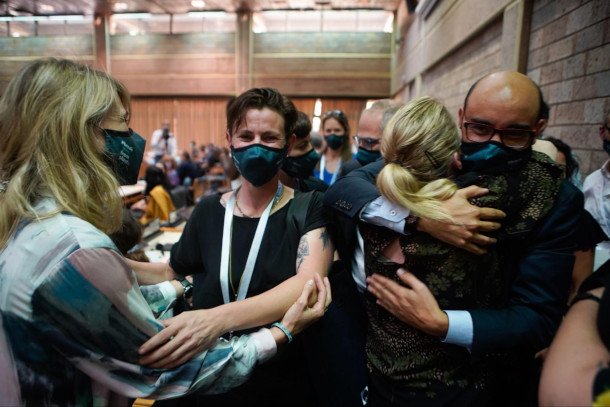
Attendees of the 2022 United Nations Environment Assembly celebrate the passing of a plastics resolution, which called for the UN to recognize and address concerns related to plastic pollution. A Global Plastics Treaty is now being negotiated. (Photo: UNEP/ Cyril Villemain, Flickr, CC BY-NC-SA 2.0)
CURWOOD: So if I'm hearing you correctly, if you were in charge of everything, you would simply get rid of plastics from our society, at least the way that they're made right now.
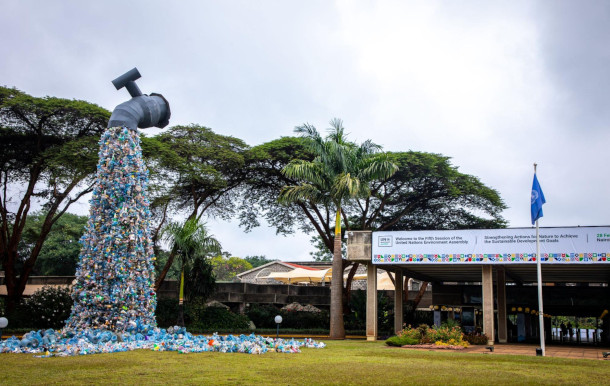
An art installation showing plastic waste flowing from a “tap” at the 2022 United Nations Environment Assembly. (Photo: UNEP/Ahmed Nayim Yussuf, Flickr, CC BY-NC-SA 2.0)
TRASANDE: Well, I wouldn't get rid of essential plastic. There is a distinction here. I use the analogy of the cucumber wrapped in the proverbial plastic tight wrap. That cling wrap has no use. No logical use. During the pandemic, when I started flying again, I would see these tray tables be delivered to me with an extra two layers of plastic wrapped under the guise of well, I'm trying to prevent COVID by doing this. COVID is transmitted by air particles, not by droplets. So it was the biggest plastic theater episode that I have ever witnessed. We seem to have gotten into the mindset that plastics is the future. Plastics have definitely provided crucial innovations to our life as a society. But the pendulum has swung way too far. We are excessively focused on profiting from finding any potential use of plastic in our life.
[MUSIC: Biff Smith, “Five of a Kind” on Biff Smith Solo Piano, by Biff Smith, self-published]
CURWOOD: We’ll be back after the break with more from our conversation with Leo Trasande about chemicals in plastics, including solutions. Stay tuned to Living on Earth.
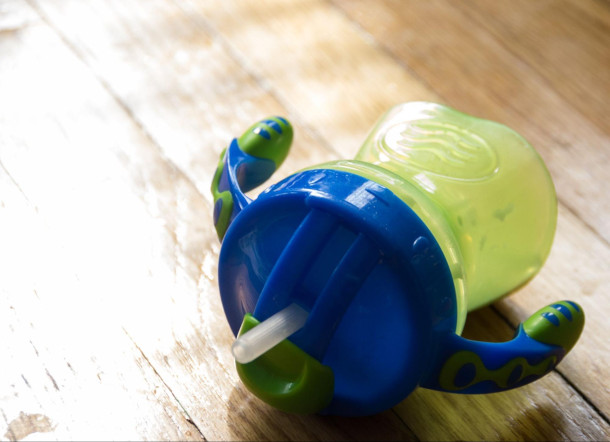
Although the FDA banned Bisphenol A (BPA) in baby bottles and sippy cups in 2012, it did not prohibit the use of the chemical in water bottles and other plastic containers. (Photo: Andrew Seaman, Flickr, CC BY-ND 2.0)
[MUSIC: Biff Smith, “Five of a Kind” on Biff Smith Solo Piano, by Biff Smith, self-published]
ANNOUNCER: Support for Living on Earth comes from Sailors for the Sea and Oceana. Helping boaters race clean, sail green and protect the seas they love. More information at sailorsforthesea.org.
[CUTAWAY MUSIC: Jimmy Smith/Thornel Schwartz/Donald Bailey, “Willow Weep for Me” on At the Organ, Volume 3, by Ann Ronell, Blue Note Records]
BELTRAN: It’s Living on Earth, I’m Paloma Beltran.
CURWOOD: And I’m Steve Curwood.
We’re back now with pediatrician Leonardo Trasande with more about the enormous costs of toxic substances used in plastics. These chemicals are powerful endocrine or hormone disruptors linked to health problems as varied as fertility issues, developmental delays and obesity, just to name a few. Even so-called bioplastics made from vegetable oils, food waste and cornstarch instead of petroleum are often laced with them. But there’s little regulation of the consumer products and even food packaging that chemicals like PFAS, phthalates, and Bisphenol A or BPA wind up in.
TRASANDE: Well, we've generally failed, particularly when it comes to the Food and Drug Administration. Take BPA or Bisphenol A, for example. We knew that it was a problem back in 2008. So the FDA banned it in baby bottles and sippy cups but didn't ban it in any other plastic materials. Let's go to phthalates now. The Consumer Product Safety Commission banned eight phthalates in toys, or restricted them to a very low level. The Food and Drug Administration has only limited two of those eight. So talk about a logical inconsistency. It's not as though kids don't eat food from packaging the same way they play with toys.
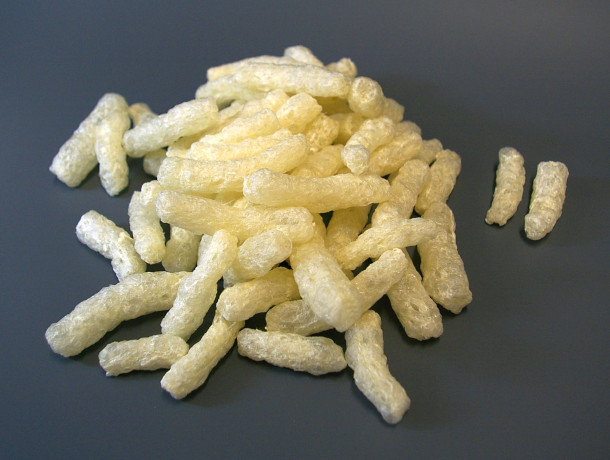
Bioplastic packing peanuts. Bioplastics come from biological sources such as starches or vegetable oils. Although they are sometimes advertised as safer than petroleum-derived plastic, they can also contain endocrine disrupting chemicals. (Photo: Christian Gahle, nova-Institut GmbH, CC BY-SA 3.0)
CURWOOD: To what extent is dealing with this problem a bit of "whack-a-mole"? Because when one type of chemical is taken off the market, let's say Bisphenol A, industry comes up with Bisphenol S. How safe are the alternatives that industry has been putting forth when certain chemicals are identified as problematic?
TRASANDE: Unfortunately, the little we see is that these are not safer. Bisphenol S is a prototype example. It's as estrogenic, as toxic to embryos and as persistent to the environment. Bioplastics are often proposed as a whole other alternative. But what little we know about bioplastics, which you would assume are naturally derived and safe, right? Nope. They are as endocrine active and endocrine disrupting as the chemically based plastic. There are safe materials. It's just that we have become aware of the many different ways in which things that we thought were safe are actually not.
CURWOOD: So for someone who's listening to us right now and concerned about this, what steps can they take to protect themselves and our society as we wait for some sort of response from the politicians that govern our regulations?
TRASANDE: So there are safe and simple steps we can take in our lives to reduce our plastic footprint and protect ourselves. If you need to use plastic, particularly don't machine wash or microwave plastic. The chemicals in some cases we're talking about are not covalently bound to plastic and the harsh ingredients and high temperatures can lead to degradation and eventually absorption of those chemicals into food more readily. Also, avoiding certain recycling number plastics is important because three is for polyvinyl chloride, which typically adds phthalates. Six is polystyrene, which breaks down into styrene, a known carcinogen. And seven is typically for polycarbonate plastics, which include bisphenols. But more generally, we can reduce our use of plastic. People use plastics in our daily lives when they actually could save money and save grief by using glass or stainless steel.

Dr. Leonardo Trasande is a pediatrician who directs the NYU Center for the Investigation of Environmental Hazards. (Photo: Cheryl Stockton)
CURWOOD: This is so overwhelming that a quarter of a trillion dollars every year, it's costing people in this country, in other words, every four years that's a trillion dollars, because of the health effects from plastics. It's a huge number, it's overwhelming. What gives you hope?
TRASANDE: What gives me hope is we've seen decreases in levels of these chemicals of concern over the past two decades. BPA levels, for example, have declined as attention to BPA-free materials has come into vogue. Now that's come with some unfortunate consequences, there are some replacements of BPA that are starting to come on the scene and detectable in people. But again, the awareness has fundamentally changed. And the more we keep growing awareness of this issue, people will use the power of the pocketbook or wallet to drive the change they seek. Ultimately, these companies are accountable to the consumer. So it's the consumer that gives me hope, not to mention the fact that with the attention to climate change, particularly among Generation Z, you have a spirit of awareness that is there that hasn't been there before.
CURWOOD: Dr. Leo Trasande is a pediatrician who directs the NYU Center for the Investigation of Environmental Hazards. Thanks so much for taking the time with us today.
TRASANDE: Always a joy to be with you Steve. Thanks again.
Links
New York University | “Center for Investigations of Environmental Hazards”
Living on Earth wants to hear from you!
Living on Earth
62 Calef Highway, Suite 212
Lee, NH 03861
Telephone: 617-287-4121
E-mail: comments@loe.org
Newsletter [Click here]
Donate to Living on Earth!
Living on Earth is an independent media program and relies entirely on contributions from listeners and institutions supporting public service. Please donate now to preserve an independent environmental voice.
NewsletterLiving on Earth offers a weekly delivery of the show's rundown to your mailbox. Sign up for our newsletter today!
 Sailors For The Sea: Be the change you want to sea.
Sailors For The Sea: Be the change you want to sea.
 Creating positive outcomes for future generations.
Creating positive outcomes for future generations.
 Innovating to make the world a better, more sustainable place to live. Listen to the race to 9 billion
Innovating to make the world a better, more sustainable place to live. Listen to the race to 9 billion
 The Grantham Foundation for the Protection of the Environment: Committed to protecting and improving the health of the global environment.
The Grantham Foundation for the Protection of the Environment: Committed to protecting and improving the health of the global environment.
 Contribute to Living on Earth and receive, as our gift to you, an archival print of one of Mark Seth Lender's extraordinary wildlife photographs. Follow the link to see Mark's current collection of photographs.
Contribute to Living on Earth and receive, as our gift to you, an archival print of one of Mark Seth Lender's extraordinary wildlife photographs. Follow the link to see Mark's current collection of photographs.
 Buy a signed copy of Mark Seth Lender's book Smeagull the Seagull & support Living on Earth
Buy a signed copy of Mark Seth Lender's book Smeagull the Seagull & support Living on Earth

